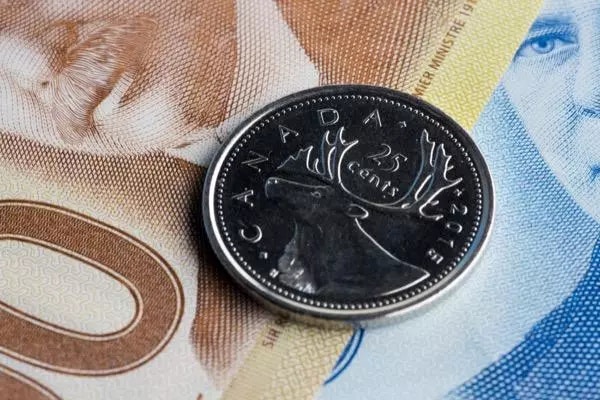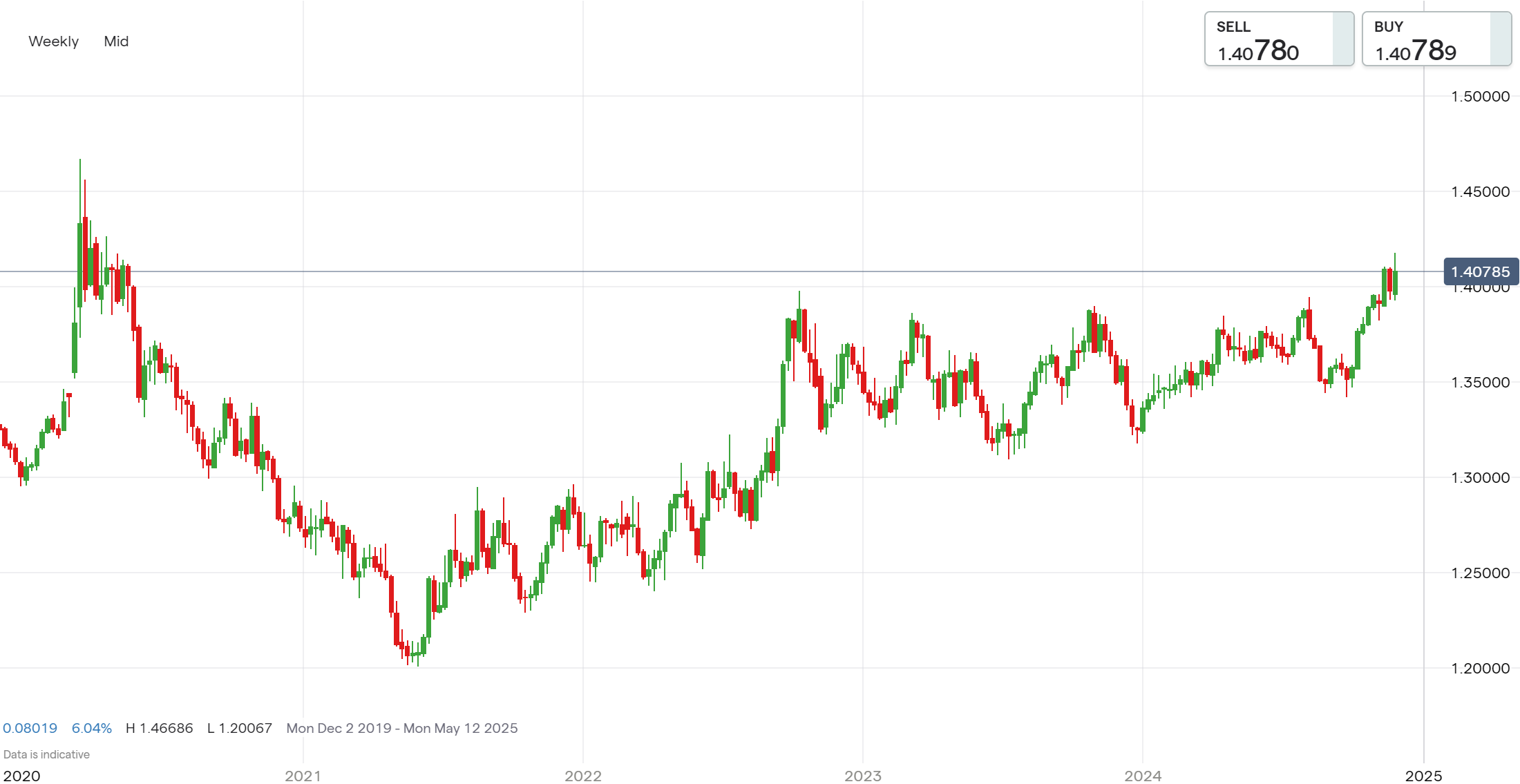USD/CAD price action: How might Trump’s tariffs affect the loonie?
USD/CAD nears 1.4180 as tariffs pressure the loonie amidst resilient economic indicators and shifting interest rate expectations, with traders watching for further market-moving data.

Key points
- USD/CAD trades at 1.41779, lowest level since mid-2020
- Canadian inflation rate rises to 2.6% in October
- Trump's tariffs include a 25% increase on Canadian exports
- US dollar index (DXY) surpasses 107.5, a two-year high
- Bank of Canada rate cut likelihood reduced by strong data
USD/CAD nears 1.4180 amid economic data releases
The Canadian dollar weakened by nearly 1% to trade at 1.41779 per USD, reaching its lowest point since mid-2020. Meanwhile, although the Bank of Canada is forecasted to continue reducing interest rates next month, the chances of another 50bps cut have lessened after higher-than-expected inflation figures. The trimmed-mean core inflation rate, a key metric for the BoC, rose to 2.6% in October, exceeding forecasts. This increase was backed by strong economic indicators such as lower unemployment and robust PMI data. The depreciation of CAD could be due to open fears of economic strain from increased US tariffs, which can potentially hinder Canadian exports. Additionally, while the expectation of interest rate cuts could further weaken CAD, the lessened likelihood of a significant cut due to strong economic data may offer some support. However, the interplay of trade tensions and domestic economic resilience will continue to influence the CAD's movement in the forex market.
USD/CAD price history

Canada, commodities, and Trump’s tariff threats
This Canadian dollar depreciation followed president-elect Donald Trump's announcement of increased tariffs, with a 10% hike on China and a 25% increase on Mexico and Canada. As oil, gas, and energy products are Canada's primary exports to the US, alongside vehicles, these tariffs could significantly impact the Canadian economy. With tariffs making Canadian exports (such as oil prices) more expensive and less attractive to US buyers, Canada's trade balance might suffer. Reduced exports can lead to a trade deficit, affecting the overall economic health negatively. However, a weaker currency can make Canadian assets more attractive to foreign investors, as they can acquire more with their stronger currencies. This can lead to increased foreign direct investment, which can stimulate economic growth and job creation.
A strong US dollar and its impact
Today, the dollar index (DXY) climbed to over 107.5, marking its highest point in over two years. The dollar's rise was supported by Donald Trump’s threats to raise tariffs, and anticipation of his policy changes that could affect inflation and interest rates. Yesterday, the US dollar index fell by around 0.6% after Trump nominated hedge fund manager Scott Bessent as Treasury Secretary, bringing stability confidence to the markets. Traders are now focused on the upcoming release of FOMC minutes to gauge the Fed's future plans. Additionally, PCE inflation data and the second GDP growth estimate are expected this week.
What’s next for USD/CAD?
As Canada's economy heavily depends on oil, gas, and vehicle exports to the US, these potential tariffs could hinder trade, possibly leading to a trade deficit and further weakening the Canadian dollar. However, despite these challenges, the loonie might find some support due to the Bank of Canada's recent decision-making landscape. While rate cuts could further pressure the CAD, the stronger-than-expected inflation data and robust economic indicators like low unemployment and strong PMI readings lessen the likelihood of a significant rate cut. This domestic economic resilience could temper some of the negative effects of the tariffs.
On the flip side, the US dollar has been gaining strength, bolstered by increased tariffs and anticipation of policy changes affecting inflation and interest rates. The strong dollar, combined with trade tensions, puts additional pressure on the CAD. However, the ongoing release of key economic data, including FOMC minutes and PCE inflation, will provide further insights into the Federal Reserve’s plans, potentially impacting the USD/CAD dynamics.
While the Canadian dollar faces headwinds from trade tensions, a weaker CAD could attract foreign investment, offering a silver lining amid tariffs. This complexity in trade, economic resilience, and interest rate expectations will continue to shape the USD/CAD's future movement. Traders should remain attentive to both countries' economic signals and geopolitical developments to anticipate further shifts in the USD/CAD pair.
More where that came from: check out what’s new in forex today on our YouTube channel:
How to trade USD/CAD?
- Open an account to get started, or practice on a demo account
- Choose your forex trading platform
- Open, monitor, and close positions on USD/CAD
Trading forex requires an account with a forex provider like tastyfx. Many traders also watch major forex pairs like EUR/USD and USD/JPY for potential opportunities based on economic events such as inflation releases or interest rate decisions. Economic events can produce more volatility for forex pairs, which can mean greater potential profits and losses as risks can increase at these times.
You can help develop your forex trading strategies using resources like tastyfx’s YouTube channel. Our curated playlists can help you stay up to date on current markets and understanding key terms. Once your strategy is developed, you can follow the above steps to opening an account and getting started trading forex.
Your profit or loss is calculated according to your full position size. Leverage will magnify both your profits and losses. It’s important to manage your risks carefully as losses can exceed your deposit. Ensure you understand the risks and benefits associated with trading leveraged products before you start trading with them. Trade using money you’re comfortable losing. Past performance is not indicative of future results.
